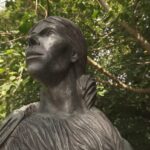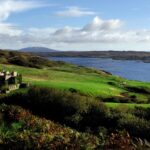Connemara is renowned for its breathtaking beauty, an absolute must to behold during your visit! Below, we’ve compiled everything you can anticipate from this remarkable area.
- Clifden
Set between the Atlantic Ocean, 12 Ben Mountains, and preserved boglands, lies the town of Clifden on the Coast of Connemara.
Enhanced by spectacular scenery, championship golfing, horse-riding, walking, cycling, hill walking, beaches, fishing, scuba diving, painting, national parks, abbeys, castle ruins and over 5,000 years of living history. You can take a wonderful walk up the Sky Road, a great way to see the wonderful backdrop to the town along with the two church spires, which give Clifden its distinctive skyline.
Along the Sky Road is a gateway leading to the ruins of the old D’Arcy mansion, Clifden Castle. Once a Gothic Mansion, the D’Arcy’s lived here until 1850 when the estate was sold to the Eyre Family who lived here at intervals until the castle fell into ruin in the early 20th century. Clifden town ‘the Capital of Connemara’ oozing history, heritage, culture & traditions of Irish Music and Dance.
This vibrant town has an array of shops ranging from quality gifts, souvenirs, and sweaters, to fashionable boutiques, antique shops and art galleries. There are many cosy coffee shops, bakery, and pubs that are genuine ‘quaint-Irish’ to the more trendy where entertainment is plentiful with traditional, modern music and dance. Clifden has a reputation for the West’s ‘Gourmet Capital’ – it has the finest of restaurants from fine dining to pub food.
- Ballyconneely
Ballyconneely is an ideal place to explore the stunning beaches and Connemara Ponies that Connemara have to offer.
The village is host to an annual Pony, Dog and Cattle Show which happens every July and continues to grow both in numbers taking part and spectating. Beautiful beaches include the Coral Strand and Mannin Bay where many water sporting activities take place including surfing, kayaking and stand-up paddle boarding. Pony trekking along the shoreline is also available or why not enjoy a spot of golf at the Connemara Championship Golf Course.
The castle ruin of Pirate Queen Granuaile (Grace O Malley) overlooks the Connemara Smokehouse which is the oldest smokehouse in Connemara and both are located at Bunowen Pier.
- Roundstone
Roundstone is a popular holiday resort renowned among artists and naturalists for the remarkable beauty of the surrounding mountains and seascapes. It has a traditional craft centre and local activities include Connemara Pottery, Connemara Jewellery and Connemara Instrument making. Connemara Farming, Connemara Fishing, Connemara Forestry and Connemara Quarrying are carried out extensively in the area. In Roundstone you will find a busy harbour where local fishermen prepare and return with the day’s catch, featuring a mix of Lobster, Crab, Shrimp, Mackerel, Cod plus a wide variety of other fish.
The town itself boasts a good selection of Bars and Seafood Restaurants crammed full of locally caught seafood. Strolling through the town you will discover some fantastic craft shops and cafés.
- Cleggan
The focal point of the picturesque village of Cleggan is its pier which is the closest mainland link for the islands of Inishturk and Inishbofin. These islands attract more and more visitors each year. Indeed so compelling are the islands charms that some have opted to live there permanently.
There are a couple of pubs with great seafood on their menu overlooking the pier. Just off the coast about five miles away is the island of Inishbofin. Cleggan is where you get the ferry to reach this island with boats going to the island daily. Cleggan and Inishbofin are renowned for being an ideal place for artists and writers, Richard Murphy the famous poet being one of them. He lived in Cleggan for many years. Bird watching is also a favourite pastime for many who stay.
- Letterfrack
Letterfrack is a village located in County Galway, Ireland. It’s situated in the Connemara region, known for its rugged landscapes, stunning coastlines, and rich cultural heritage. Letterfrack is particularly notable for its proximity to Connemara National Park and its association with education and craftsmanship.
One of the main attractions near Letterfrack is Connemara National Park. The park encompasses a diverse range of landscapes, including mountains, bogs, grasslands, and woodlands. Visitors can enjoy hiking trails, educational exhibits, and breathtaking views of the surrounding countryside. Diamond Hill is a popular hiking destination within the park, offering panoramic views from its summit.
Letterfrack is home to the ATU Letterfrack Campus, which is renowned for its Furniture Design and Wood Technology programs. The college has played a significant role in promoting craftsmanship and design skills related to furniture-making and woodworking.
The village has a strong connection to traditional crafts and design. You might find artisan shops and studios showcasing locally made crafts, artwork, and other creative products.
Letterfrack is a small village with a tight-knit community. It offers a glimpse into rural Irish life, with charming architecture, local businesses, and friendly locals.
Letterfrack’s location in Connemara provides access to a wide range of outdoor activities, including hiking, cycling, fishing, and exploring the rugged coastline. It’s also a popular destination for those seeking to experience the natural beauty and cultural heritage of the region.
- Renvyle
With its numerous beaches including The White Strand and Lettergesh Beach and stunning mountain views, the Renvyle Peninsula begins shortly after Letterfrack when driving north-west on the Tullycross road.
The bustling villages of Tully and Tullycross both offer warm welcomes to its visitors and during the summer months, the village of Tully opens its doors at the Teach Ceoil (Music House) for a celebration of Irish music, dance and story-telling in the form of Irish Nights where local performers showcase their talents. Every August the return of the local annual Watersports Day takes place on Glassilaun beach.
- Leenane
Situated at the head of Killary harbour, Leenane village lies on the Galway-Mayo border under the Maamtrasna and Maamturk mountains. Famous for its stunning views and beauty, it is home to Irelands only fjord which is a stretch of 16km and was the set for the famous Irish movie, The Field.
Leenane has many outdoor sporting activities to offer from water sports, fishing, golfing and mountain hiking to something more relaxing like local seaweed baths, cruises along the Killary or a spot of shopping at the Sheep and Wool centre in the heart of the village.
- Spiddal & Barna
Leaving Galway along the coastal route to Connemara, the creative and colourful villages of Barna and Spiddal await. The gateway to Connemara is the first of the Gaeltacht areas in Connemara and welcomes you to enjoy some time out at their beautiful beaches like Silver Strand and Spiddal beach or to take a stroll in the natural woodland trails in Barna woods.
See the local fisherman head off from Spiddal pier to grab the local catch of the day or take some time out to enjoy the stylish fashion in Design House or Standún and while you’re there, why not try and pick up some Irish from the locals and impress all your friends!
- Oughterard
Oughterard is a traditional village steeped in history and is set at the gateway of the Connemara mountains and home to the Owenriff River which empties into the Lough Corrib. Known for its lively water activities such as boat hire, fly and fresh water fishing, heritage walks, Oughterard is within 20km west from Galway city and offers something for all the family to enjoy both in the village itself and on the outskirts.
- Galway City
Just over an hours drive from Clifden, the oldest and largest city on the Wild Atlantic Way Galway city awaits you. With historical sites like the Spanish Arch, Galway Cathedral and of course Eyre Square to the wonderful Atlantic Ocean via the Salthill promenade, the energetic city of the tribesmen has something for everyone to enjoy and will certainly keep you busy.
There is a huge variety of shopping available, various tours of the city by way of train and also by horse drawn carriage, street entertainment to get your toes tapping and a food scene that will most definitely not disappoint. Annual festivals include the Galway International Arts Festival, the Galway Races and the Galway Christmas Market.
- Carna
Carna is a small coastal area in south Connemara which is in the heart of the Gaeltacht (Irish-speaking) area of Connemara. Carna is a small area, but it has a large enough influence on the surrounding areas in Connemara as it contains a Garda Síochána station, a Health Centre including a Rapid Response Ambulance and it also houses an Irish Coastguard lifeboat. Carna is located close to the village of Cill Chiarain and they share the peninsula locally called Iorras Aithneach.
There are 4 shops and 3 pubs located in Carna Village. A bus is also based in Carna that brings passengers between Carna and Galway City picking up passengers along the N59.
There are several beautiful white sandy beaches to be found in the Carna area. Mynish, Moyrus, Callowfeenish & Feenish Island are lovely, quiet and secluded beaches where you will find some of the most breathtaking sea views in Connemara.
There are plenty of delightful local walks in the Connemara area where you can discover the local beaches, bog lands, flora, and fauna and take some excellent holiday snaps!
Carna is a 40-minute drive from the famous Connemara Golf Links course in Ballyconneely. Barna golf course is approx 68 km away from Carna Village (about an hour drive). Oughterard Golf Course is approx 52 Km away (50 minute drive). There is also a picturesque Pitch and Putt course approx a 15 minute drive away.
- Rosmuc
Rosmuc is situated in the western part of County Galway, facing the Atlantic Ocean. It’s part of the Connemara Gaeltacht, which means that the Irish language (Gaeilge) is often spoken alongside English in this area.
Rosmuc is known for its strong cultural ties to the Irish language and traditional Irish ways of life. The village and its surrounding areas are considered an important centre for preserving and promoting the Gaelic language and culture.
Rosmuc is notable for its connection to historical figures such as Patrick Pearse, a leader of the 1916 Easter Rising and a prominent figure in the Irish nationalist movement. Pearse had a summer residence in Rosmuc, and his involvement in the area contributed to its historical significance.
The village is surrounded by the picturesque landscapes that Connemara is known for, rolling hills, rugged coastlines, and scenic vistas are characteristic of the area.
A small village with a close-knit community. It might not be as well-known as some larger towns, but it offers an opportunity to experience the authentic rural lifestyle of Connemara.
Visitors to Rosmuc might have the chance to experience traditional music sessions, storytelling, and other cultural events that celebrate the local heritage. The area’s natural beauty also lends itself to outdoor activities such as hiking, fishing, and exploring the coast.
The Connemara Gaeltacht is renowned for its emphasis on the Irish language and preserving Gaelic traditions. Signs, conversations, and local events are often conducted in Irish, creating a unique linguistic and cultural atmosphere.






